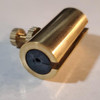Trusted Gollihur Music Partner
Brass Wolf Tone Eliminator (Suppressor) for Double Bass
We ship worldwide! (Read this)
- Small Accessory:
- This item ships FREE (USA) in a cart totaling $100 or more
Description
You've probably heard the term "wolf tone" from your bassist or other stringed instrument friends. It's a commonly misunderstood concept, but not a rarity on bowed stringed instruments (and is particularly common with carved instruments). There are various methods of "eliminating" or "moving" (changing the affected pitch of) wolf tones. A simple eliminator like this one is a simple, inexpensive and common solution.
What is a "Wolf Tone?"
Put simply, it's an artificial overtone. It occurs because your bass has a frequency at which - due to its physical size - it naturally over-resonates. It's kind of like a drum having a particular tuning at which it sounds best (which is fine for drums, but we bassists have many different notes to play on the same instrument!) On a bass, when you play the note that is of that same resonating frequency (or very close to it), you get a sustained overtone along with the pitch of the string being played. This can cause a note that "jumps out" more than other notes, as well as cause that "beating" sound you hear when you play the same note on two strings that aren't quite in tune with each other.
It's probably called a "Wolf Tone" since that "beating" can be reminiscent of the howling of that animal. Since basses generally have fairly similar sizes, the wolf tone (when found) on a bass is often around "G."
"How do I get rid of the Wolf Tone?"
You don't really get rid of it, but you can often reduce or slightly "shift" the wolf tone. You can add a wolf tone suppressor, like the one on this page, to the afterlength (the part of the string between the bridge and tailpiece) on the string upon which the wolf tone is most obviously present. By moving the weight up and down, you may be able to "dial in" that wolf tone's frequency and reduce its effects - it's sort of a "mini-attenuator" which can often decrease the intensity of that frequency. It may also cause the wolf tone to "shift," preferably to a tone "between notes" where it won't do any harm. It's a common solution to a common problem; wolf-tone eliminators have long been available for all members of the string family.
The ones we offer consist of a rubber sleeve, which is surrounded by a weighted brass collar with a set screw.
To install:
- Remove the rubber sleeve
- Place it on the afterlength of the string (the silked part between the bridge and the tailpiece)
- Put the metal collar around the rubber sleeve
- Tighten the thumbscrew, firmly but not overtightened.
You don't need to remove or detune the strings to install it - it takes only moments to install, move, or remove. No tools necessary.
This "eliminator" has a brass finish and weighs approximately 12 grams.











